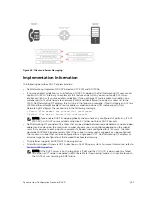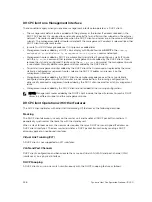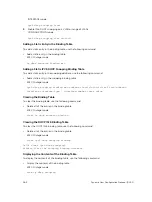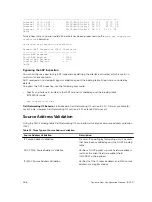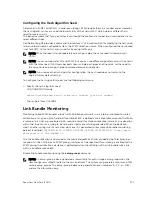
packets addressed to the client to it. As a result, the attacker is able to sniff all packets to and from the
client.
Other attacks using ARP spoofing include:
Broadcast
An attacker can broadcast an ARP reply that specifies FF:FF:FF:FF:FF:FF as the
gateway’s MAC address, resulting in all clients broadcasting all internet-bound
packets.
MAC flooding
An attacker can send fraudulent ARP messages to the gateway until the ARP cache
is exhausted, after which, traffic from the gateway is broadcast.
Denial of
service
An attacker can send a fraudulent ARP messages to a client to associate a false
MAC address with the gateway address, which would blackhole all internet-bound
packets from the client.
NOTE: Dynamic ARP inspection (DAI) uses entries in the L2SysFlow CAM region, a sub-region of
SystemFlow. One CAM entry is required for every DAI-enabled VLAN. You can enable DAI on up to
16 VLANs on a system. However, the ExaScale default CAM profile allocates only nine entries to the
L2SysFlow region for DAI. You can configure 10 to 16 DAI-enabled VLANs by allocating more CAM
space to the L2SysFlow region before enabling DAI.
SystemFlow has 102 entries by default. This region is comprised of two sub-regions: L2Protocol and
L2SystemFlow. L2Protocol has 87 entries; L2SystemFlow has 15 entries. Six L2SystemFlow entries
are used by Layer 2 protocols, leaving nine for DAI. L2Protocol can have a maximum of 100 entries;
you must expand this region to capacity before you can increase the size of L2SystemFlow. This is
relevant when you are enabling DAI on VLANs. If, for example, you want to enable DAI on 16 VLANs,
you need seven more entries; in this case, reconfigure the SystemFlow region for 122 entries using
the
layer-2 eg-acl
value
fib
value
frrp
value
ing-acl
value
learn
value
l2pt
value
qos value system-flow 122
command.
The logic is as follows:
L2Protocol has 87 entries by default and must be expanded to its maximum capacity, 100 entries,
before L2SystemFlow can be increased; therefore, 13 more L2Protocol entries are required.
L2SystemFlow has 15 entries by default, but only nine are for DAI; to enable DAI on 16 VLANs, seven
more entries are required. 87 L2Pr 13 additional L2Pr 15 L2Syst 7
additional L2SystemFlow equals 122.
Configuring Dynamic ARP Inspection
To enable dynamic ARP inspection, use the following commands.
1.
Enable DHCP snooping.
2.
Validate ARP frames against the DHCP snooping binding table.
INTERFACE VLAN mode
arp inspection
Examples of Viewing the ARP Database and Packets
To view entries in the ARP database, use the
show arp inspection database
command.
Dell#show arp inspection database
Protocol Address Age(min) Hardware Address Interface VLAN CPU
Dynamic Host Configuration Protocol (DHCP)
265
Summary of Contents for Z9000
Page 1: ...Dell Configuration Guide for the Z9000 System 9 7 0 0 ...
Page 80: ...grub reboot 80 Management ...
Page 128: ... 0 Te 1 1 Te 1 2 rx Flow N A N A 128 Access Control Lists ACLs ...
Page 491: ...Figure 70 Configuring OSPF and BGP for MSDP Multicast Source Discovery Protocol MSDP 491 ...
Page 496: ...Figure 73 MSDP Default Peer Scenario 1 496 Multicast Source Discovery Protocol MSDP ...
Page 497: ...Figure 74 MSDP Default Peer Scenario 2 Multicast Source Discovery Protocol MSDP 497 ...
Page 498: ...Figure 75 MSDP Default Peer Scenario 3 498 Multicast Source Discovery Protocol MSDP ...
Page 760: ...Figure 100 Single and Double Tag TPID Match 760 Service Provider Bridging ...
Page 761: ...Figure 101 Single and Double Tag First byte TPID Match Service Provider Bridging 761 ...

